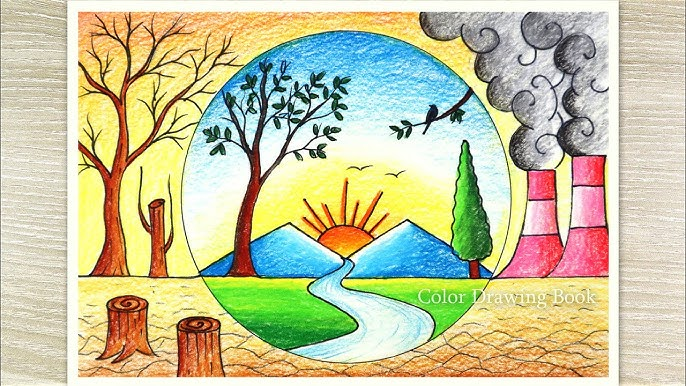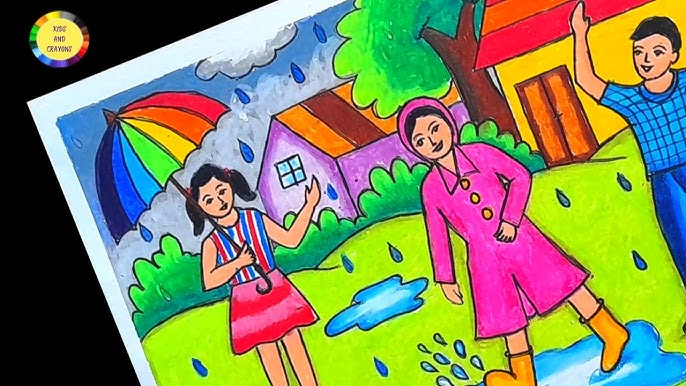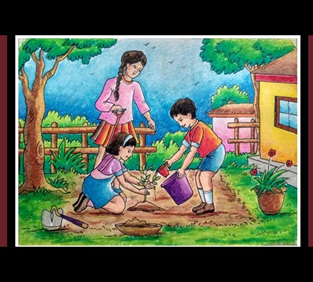Daily Lesson Plan
Class: 3–5
Topic: Composition Drawing
Learning Objective:Composition Drawing
- To develop an understanding of composition by arranging elements thoughtfully within a drawing.
- To use space, balance, and placement creatively to create visually appealing artwork.
Learning Outcome:
- Students will be able to create a composition drawing by arranging objects effectively within the space provided.
- They will demonstrate creativity, balance, and proportion in their artwork.
Key Words/Vocabulary:
- Composition
- Balance
- Proportion
- Foreground
- Background
- Overlapping
- Perspective
Cross-Curricular Link:
- Math: Understanding proportion and space.
- English: Describing their artwork and the objects they chose to draw.
- Science: Incorporating elements of nature (e.g., trees, flowers, animals).
Starter (Picture Prompt):
- Show a picture of a simple composition (e.g., a bowl of fruits, a garden, or a table setup).
- What do you notice about the objects?
- How do they fit together?
- What do you think makes the picture look complete?
Teaching & Learning Activities
Teacher Action:
- Explain the concept of composition using simple examples (e.g., arranging objects in a room, arranging fruits in a basket).
- Demonstrate how to sketch a basic composition (e.g., a table with a vase, a tree with flowers).
- Encourage discussion about the importance of balance, perspective, and proportion in art.
Learner Opportunities:
- Observe the demonstration carefully.
- Practice creating a quick thumbnail sketch to plan their composition.
- Select a theme (e.g., garden, picnic, or room interior) and create their own composition drawing.
Challenging Tasks:
- Add depth by including overlapping objects.
- Include details in the background to enhance perspective.
- Use shading techniques to add dimension to their composition.
Assessment Criteria (Self/Peer/Teacher):
- Self: Reflect on whether their drawing looks balanced and complete.
- Peer: Review a classmate’s drawing and provide constructive feedback on composition.
- Teacher: Assess the use of space, balance, and creativity in each student’s drawing.
Plenary:
- Display a few student artworks and discuss as a class:
- What works well in this composition?
- How could it be improved?
- Summarize the key points of composition drawing and its importance in art.
Home Learning:
- Create a composition drawing at home based on a theme of their choice (e.g., their favorite corner of the house or a park scene).
- Write a short paragraph describing the objects and why they chose to include them.
Resources Used:
- Reference images (picture prompts).
- Sketchbooks or drawing paper.
- Pencils, erasers, colored pencils, and markers.
Skills Used in the Lesson:
- Observation
- Creativity
- Spatial awareness
- Planning and problem-solving
Next Step of Learning:
- Explore advanced composition techniques like perspective drawing.
- Learn to include human figures or animals in compositions.
- Use different mediums (e.g., watercolors, charcoal) for their compositions.
|
Criteria |
Excellent (4) |
Good (3) |
Satisfactory (2) |
Needs Improvement (1) |
|
Creativity & Theme |
Unique and imaginative composition with a clear theme. |
Clear theme with some creative elements. |
Theme is basic with limited creative effort. |
Theme is unclear or lacks creativity. |
|
Use of Space |
Excellent use of space; balanced arrangement of elements. |
Good use of space; most elements are well arranged. |
Space is unevenly used; some areas feel empty or crowded. |
Poor use of space; elements are disorganized. |
|
Details & Elements |
Detailed drawing with thoughtful additions (people, animals, objects). |
Includes a variety of relevant details but lacks refinement. |
Few details; minimal effort in adding extra elements. |
Limited or no effort in adding details. |
|
Proportion & Balance |
Accurate proportion; well-balanced composition. |
Proportions are mostly correct; composition is fairly balanced. |
Proportions are somewhat off; composition is imbalanced. |
Proportions are incorrect; lacks balance. |
|
Effort & Neatness |
Exceptional effort; drawing is neat and complete. |
Good effort; mostly neat with minor imperfections. |
Some effort; drawing lacks neatness in places. |
Minimal effort; drawing is incomplete or untidy. |
|
Use of Color/Shading |
Effective use of color or shading to enhance the scene. |
Good use of color or shading; adds some depth. |
Limited use of color or shading; minimal enhancement. |
No use of color or shading; scene looks flat. |
|
Overall Composition |
Engaging and visually appealing composition. |
Composition is visually appealing but less engaging. |
Composition is basic and lacks visual appeal. |
Composition is incomplete or not engaging. |
Scoring Guide:
- 28–24: Outstanding! Your composition shows excellent creativity and technique.
- 23–18: Good! You have a clear understanding but can refine some aspects.
- 17–12: Satisfactory! More practice can help improve your skills.
- 11 or below: Needs improvement. Focus on balance, details, and neatness.
· Composition: The arrangement of elements (objects, people, or scenery) in a drawing to create a complete and visually appealing picture.
· Balance: Ensuring that elements in the drawing are evenly distributed, so no part feels too empty or too crowded.
· Proportion: The size relationship between objects to ensure they look realistic (e.g., a tree should not be smaller than a person).
· Foreground: The part of the drawing that appears closest to the viewer, usually with larger and more detailed objects.
· Background: The part of the drawing that appears farthest from the viewer, often less detailed or lighter in color to show distance.
· Overlapping: Placing one object in front of another to create depth and show which objects are closer or farther away.
· Perspective: The technique used to create the illusion of depth and distance, making a flat drawing appear three-dimensional.












No comments:
Post a Comment